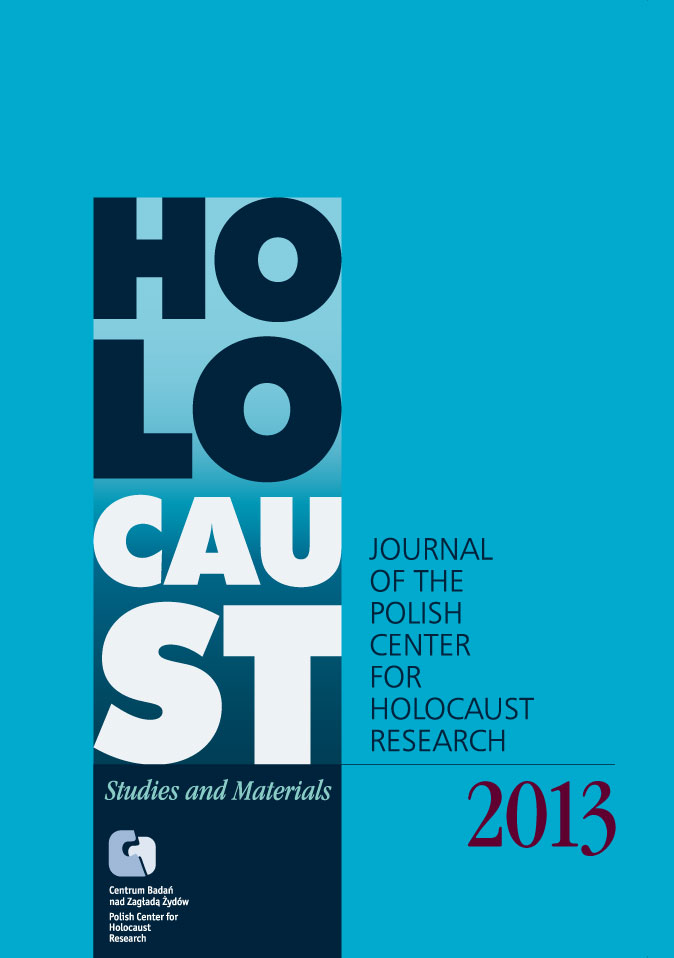Gone but not Forgotten: Archaeological approaches to the site of the former Treblinka Extermination Camp in Poland
Zagłada Żydów. Studia i Materiały, Nr Holocaust Studies and Materials (2013), Strony: 253-289
Data zgłoszenia: 2020-12-13Data publikacji: 2013-02-20
 https://doi.org/10.32927/zzsim.809
https://doi.org/10.32927/zzsim.809
Abstrakt
Public impression of the Holocaust is unquestionably centred on knowledge about, and the image of, Auschwitz-Birkenau – the gas chambers, the crematoria, the systematic and industrialized killing of victims. Conversely, knowledge of the former extermination camp at Treblinka, which stands in stark contrast in terms of the visible evidence that survives pertaining to it, is less embedded in general public consciousness. As this paper argues, the contrasting level of knowledge about Auschwitz-Birkenau and Treblinka is centred upon the belief that physical evidence of the camps only survives when it is visible and above-ground. The perception of Treblinka as having been “destroyed” by the Nazis, and the belief that the bodies of all of the victims were cremated without trace, has resulted in a lack of investigation aimed at answering questions about the extent and nature of the camp, and the locations of mass graves and cremation pits. This paper discusses the evidence that demonstrates that traces of the camp do survive. It outlines how archival research and non-invasive archaeological survey has been used to re-evaluate the physical evidence pertaining to Treblinka in a way that respects Jewish Halacha Law. As well as facilitating spatial and temporal analysis of the former extermination camp, this survey has also revealed information about the cultural memory associated with the site and how much has been forgotten about its history.
Licencja
Prawa autorskie (c) 2013 Autor&"Zagłada Żydów. Studia i Materiały"

Utwór dostępny jest na licencji Creative Commons Uznanie autorstwa 4.0 Międzynarodowe.
https://creativecommons.org/licenses/by/4.0
Czasopismo publikowane jest w standardzie Diamond Open Access na licencji CC-BY-4.0 Deed - Uznanie autorstwa 4.0 Międzynarodowa - Creative Commons
Inne teksty tego samego autora
- Caroline Sturdy Colls, O tym, co minęło, lecz nie zostało zapomniane: Badania archeologiczne na terenie byłego obozu zagłady w Treblince , Zagłada Żydów. Studia i Materiały: Nr 8 (2012)
Podobne artykuły
- Barbara Engelking, In memoriam - ISRAEL GUTMAN (1923–2013) , Zagłada Żydów. Studia i Materiały: Nr 9 (2013)
- Witold Mędykowski, The Jews are Coming Back: The Return of the Jews to their countries of origin after WW II, edited by David Bankier , Zagłada Żydów. Studia i Materiały: Nr 1 (2005)
- Joanna Nalewajko-Kulikov, Gunnar S. Paulsson, Secret City: the Hidden Jews of Warsaw 1940-1945 , Zagłada Żydów. Studia i Materiały: Nr 1 (2005)
- Mikołaj Grynberg, O Auschwitz, Szwecji i depresji , Zagłada Żydów. Studia i Materiały: Nr 10 (2014)
- Tomasz Żukowski, Polemika z recenzją Bartłomieja Krupy [Tomasz Żukowski] , Zagłada Żydów. Studia i Materiały: Nr 17 (2021)
- August Grabski, Paweł Kendziorek, Antysemityzm a społeczeństwo mieszczańskie , Zagłada Żydów. Studia i Materiały: Nr 1 (2005)
- Jean-Charles Szurek, Witold Mędykowski, Michael Meng, Emanuel Althuber, Michael Fleming, Omówienia najnowszych publikacji na temat zagłady Żydów - Francja, Izrael, USA, Austria, Wielka Brytania , Zagłada Żydów. Studia i Materiały: Nr 1 (2005)
- Jan Grabowski, Powojenne dochodzenia policyjne we Francji, czyli próba samooczyszczenia paryskiej Prefektury Policji w latach 1944–1946 , Zagłada Żydów. Studia i Materiały: Nr 9 (2013)
- Krystyna Hartman, Tak niewiele wiem [Aneks:] List Anny Lorenc napisany w więzieniu w Tarnopolu , Zagłada Żydów. Studia i Materiały: Nr 17 (2021)
- Stanisław Obirek, Każdy z nas potrzebuje czasu, czyli rzecz nie tylko o Janie Tomaszu Grossie , Zagłada Żydów. Studia i Materiały: Nr 14 (2018)
<< < 38 39 40 41 42 43 44 45 46 47 48 49 50 51 52 53 54 55 56 57 58 59 60 61 62 63 64 65 66 67 68 69 70 71 72 73 74 > >>
Możesz również Rozpocznij zaawansowane wyszukiwanie podobieństw dla tego artykułu.
 English
English
 Język Polski
Język Polski




